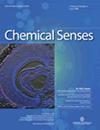来自刺五加的新型古玛素样肽及其与甜味受体 T1R2/T1R3 的相互作用
IF 1.9
4区 心理学
Q1 BEHAVIORAL SCIENCES
引用次数: 0
摘要
刺五加(Gymnema sylvestre,GS)是一种传统药用植物,以其降血糖和降血脂作用而闻名。Gurmarin(以下简称 Gur-1)是 GS 中唯一已知的活性肽。Gur-1 对啮齿动物有抑制甜味的作用,但对人类没有或只有很弱的作用。本文报告了 GS 转录组中的 8 种古尔马林样肽(Gur-2 至 Gur-9)及其同工形式。Gur-1抑制甜味的分子机制在很大程度上仍然未知。因此,通过 AlphaFold-Multimer(AF-M)预测并验证了人类和小鼠甜味受体 T1R2/T1R3 的完整结构及其与 Gur-1 至 Gur-9 的相互作用。只有 Gur-1 和 Gur-2 与 T1R2/T1R3 受体相互作用。事实上,Gur-1 和 Gur-2 与小鼠 T1R2 亚基的富半胱氨酸结构域(CRD)和跨膜结构域(TMD)区域结合。相比之下,只有 Gur-2 与人 T1R2 亚基的 TMD 结合。这一结果表明,Gur-2 在人类中可能具有抑制甜味的作用。此外,AF-M 预测参与甜味传导的蛋白质 Gα-gustducin 与 T1R2 亚基的胞内结构域相互作用。这些结果突显了GS中古香豆素样肽意想不到的多样性,并提供了人类和小鼠甜味受体的完整预测结构,以及Gur-1、Gur-2和Gα-gustducin的假定结合位点。此外,香豆素样肽可作为开发抗糖尿病分子的药物支架。本文章由计算机程序翻译,如有差异,请以英文原文为准。
Novel Gurmarin-like Peptides from Gymnema sylvestre and their Interactions with the Sweet Taste Receptor T1R2/T1R3
Gymnema sylvestre (GS) is a traditional medicinal plant known for its hypoglycemic and hypolipidemic effects. Gurmarin (hereafter Gur-1) is the only known active peptide in GS. Gur-1 has a suppressive sweet taste effect in rodents but no or only a very weak effect in humans. Here, eight gurmarin-like peptides (Gur-2 to Gur-9) and their isoforms are reported in the GS transcriptome. The molecular mechanism of sweet taste suppression by Gur-1 is still largely unknown. Therefore, the complete architecture of human and mouse sweet taste receptors T1R2/T1R3 and their interaction with Gur-1 to Gur-9 were predicted by AlphaFold-Multimer (AF-M) and validated. Only Gur-1 and Gur-2 interact with the T1R2/T1R3 receptor. Indeed, Gur-1 and Gur-2 bind to the region of the cysteine-rich domain (CRD) and the transmembrane domain (TMD) of the mouse T1R2 subunit. In contrast, only Gur-2 binds to the TMD of the human T1R2 subunit. This result suggests that Gur-2 may have a suppressive sweet taste effect in humans. Furthermore, AF-M predicted that Gα-gustducin, a protein involved in sweet taste transduction, interacts with the intracellular domain of the T1R2 subunit. These results highlight an unexpected diversity of gurmarin-like peptides in GS and provide the complete predicted architecture of the human and mouse sweet taste receptor with the putative binding sites of Gur-1, Gur-2 and Gα-gustducin. In addition, gurmarin-like peptides may serve as promising drug scaffolds for the development of antidiabetic molecules.
求助全文
通过发布文献求助,成功后即可免费获取论文全文。
去求助
来源期刊

Chemical Senses
医学-行为科学
CiteScore
8.60
自引率
2.90%
发文量
25
审稿时长
1 months
期刊介绍:
Chemical Senses publishes original research and review papers on all aspects of chemoreception in both humans and animals. An important part of the journal''s coverage is devoted to techniques and the development and application of new methods for investigating chemoreception and chemosensory structures.
 求助内容:
求助内容: 应助结果提醒方式:
应助结果提醒方式:


